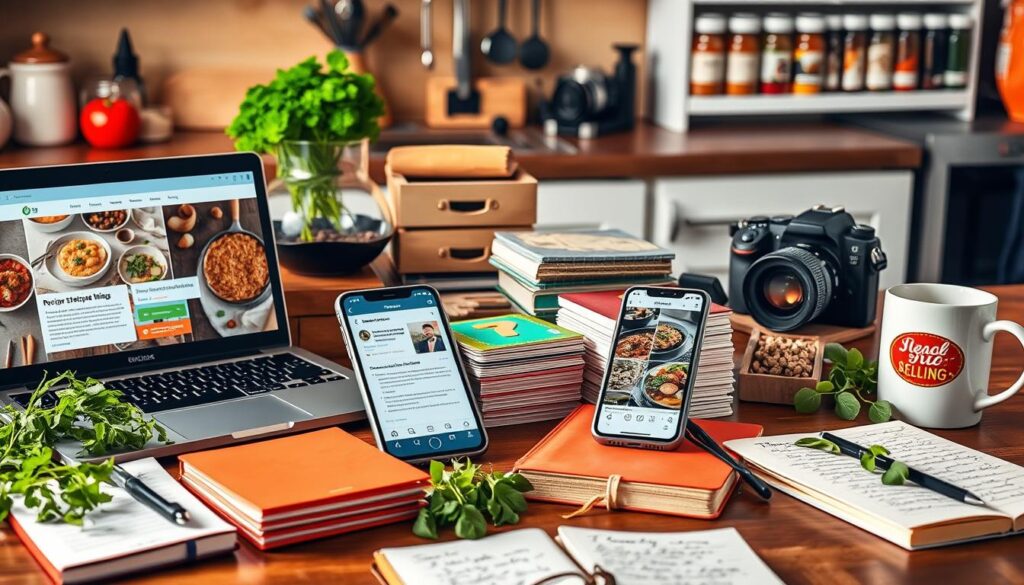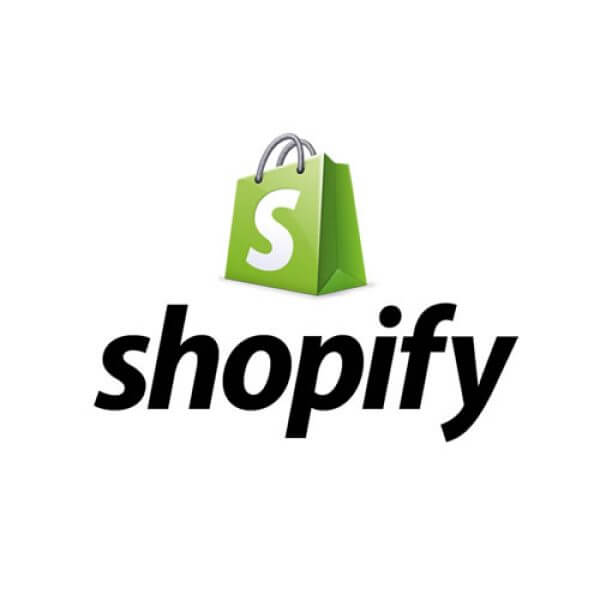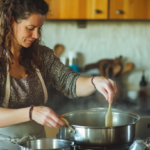The world of culinary arts is competitive. To succeed, you need good tools and resources for selling recipes. They help whether you’re just starting at home or you’re already a pro chef. So, learning how to sell recipes online and finding your audience can be easy.
We’ll show you the top platforms for selling your recipes. Also, the essential tools for making recipes like a pro, and how to market them. You’ll learn about digital kitchen scales and great recipe software. This info will take your culinary business to the next level.
Key Takeaways
- Leveraging digital tools can significantly enhance recipe organization and sales.
- Effective marketing strategies are crucial for capturing and retaining your culinary audience.
- Selecting the right digital kitchen tools improves recipe quality and professionalism.
- Utilizing high-quality recipe management apps ensures efficient tracking and organization of your recipes.
- Clear and precise recipe writing boosts reader engagement and replicability of dishes.
Best Recipe Selling Platforms
The digital age is changing the cooking world. Chefs and food bloggers now sell recipes online to make money. It’s key to find a great platform to reach the booming online food market. We look closely at some popular choices to help you pick wisely.
Key Features
Think about these important things when picking a platform:
- User Interface: It should be easy and nice to use.
- Customer Reach: A good platform attracts lots of people, making you more visible.
- Monetization Options: Check for different ways to make money, like subscriptions or ads.
- Ease of Use: Uploading and managing recipes should be simple and save time.
Platform Comparison
Looking at different online platforms can help you sell recipes better. Here are some top sites to think about:
- Patreon: This site has a subscription model, so chefs get regular money from fans.
- Shopify: A big ecommerce platform for selling digital items easily, with lots of customization options.
- Teachers Pay Teachers: Though it’s mainly for teaching resources, it also offers stuff for food businesses, great for those teaching about food.
- Gumroad: Perfect for selling individual recipes and small digital items, very easy to use.
Each platform offers something special. Think about what you need so you can grow your food business the best way.
Essential Tools for Professional Recipe Creation
Making great recipes requires exact measurements and steady results. This is only possible with the right tools. For those in the food business, top-notch kitchen gear is essential for winning. Digital kitchen scales and quality mixing bowls are key for exactness and reliability in cooking.
Digital Kitchen Scales
Getting measurements right is crucial for recipes that wow every time. Digital scales give the accuracy needed to beat the common issue of ingredients being off by 25-40% when measured by volume. For example, perfect bread needs a precise mix of flour to water, usually 5 to 3. Scales help bakers adjust the recipe size perfectly, whether making dozens of cookies or a huge cake.
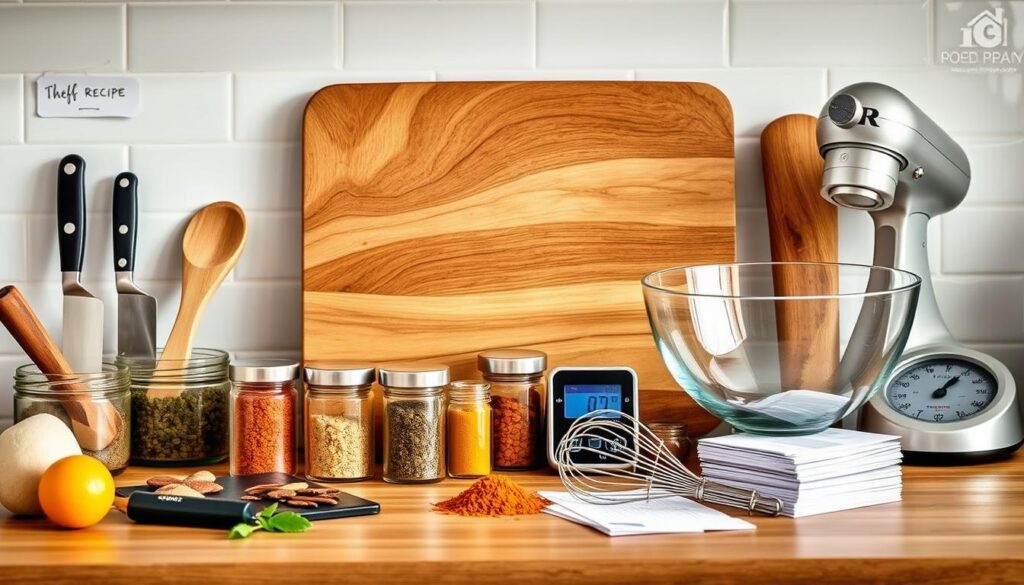
Quality Mixing Bowls
Good mixing bowls are just as vital. They make sure ingredients mix well and in the right amount. The size of the bowl affects how much you can make at once. A 5-quart bowl should not be more than 75% full for cake mix, and 50-60% full for doughs. Overfilling can damage mixers. Using the right size bowl keeps the quality of your recipes high.
To sum up, having digital kitchen scales and good mixing bowls is crucial for food entrepreneurs. This gear helps you make recipes that are accurate, can be made larger or smaller, and stay consistent. This is what leads to success in the culinary world.
Effective Marketing Tools for Recipes
To effectively market your recipes online, you’ll need a mix of digital tools and smart strategies. Let’s explore essential platforms and tips for those who dream of culinary success:
- Social Media Advertising: Using Instagram, TikTok, and Pinterest is key since 93% of marketers see big gains in brand exposure from it. Influencer marketing is also powerful, being 11 times more impactful than standard online marketing for food-related brands.
- Email Marketing Campaigns: Tools like Mailchimp (starting at $13/month) and ActiveCampaign ($29/month) enable personalized email marketing. This keeps your audience excited about new recipes. Interacting in comments and messages increases brand loyalty by more than 60%.
- SEO Strategies: Optimizing for local SEO is critical with 46% of Google searches seeking local info. Tools like Google Analytics 4 (free) and Ahrefs (from $83/month) for keyword searching can significantly elevate your online presence.
- User-Generated Content: UGC can quadruple advertising effectiveness. Since 78% of consumers trust peer recommendations, UGC is crucial.
- Visual Appeal and Packaging: Quality images and attractive packaging can lift sales by 30% and skyrocket social media engagement by 650%. Canva (from $120/year) and Piktochart ($14/month) help create appealing visuals effortlessly.
“Approximately 78% of consumers trust recommendations from other consumers, highlighting the importance of user-generated endorsements.”
For a deep dive into online recipe sales, see this detailed guide on how to make money selling recipes.
Also, keep an eye on market trends, like seasonal favorites. Applying targeted strategies for occasions like summer BBQs or holiday meals can boost your success even further.
Recipe Organization Software
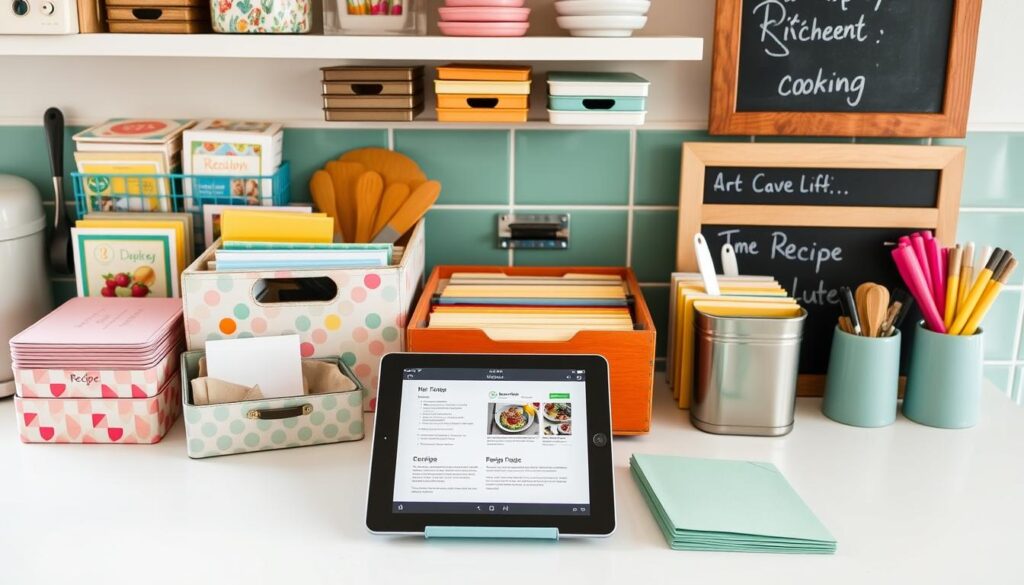
Recipe organization software has changed the game for food lovers and chefs. It lets them store and manage recipes easily. With smart designs and powerful features, digital recipe management tools make kitchen work smoother.
Top Recipe Management Apps
Meez is a hit among 30,000 culinary pros. It’s packed with features, like handling over 2,500 ingredients for exact food costing and menu checks. It suits everyone, from fast-food joints to home kitchens. Meez and Apicbase boost work by syncing ingredient costs and calculating food costs in real time. These recipe organization tools let users immediately see how recipe changes affect earnings and profit margins.
Apicbase also works well with inventory and POS systems to keep stock levels right and optimize menu results. It isn’t just a tool, but a comprehensive solution that boosts professional efficiency in many kitchen settings. Apps like Paprika Recipe Manager and Cook’n Recipe Organizer stand out for importing recipes online and analyzing nutrition.
How to Digitally Catalog Recipes
Keeping recipes digitally makes them easy to find, well-organized, and saves you from messy notes. With digital recipe management tools, you can add recipes, organize them, and even change ingredients easily. For example, ReciPal is great for small food businesses to figure out serving costs with current ingredient prices. It’s perfect for chefs keeping an eye on the budget. Platforms like BigOven and Yummly give huge recipe collections and personalized tips, making meal planning a breeze.
When picking these software tools for your cooking business, make sure they meet your needs. Whether you need Apicbase for tracking inventory in real-time or Cook’n for detailed nutrition tracking.
Recipe Writing and Formatting Tools
For any culinary expert, making recipes both easy to understand and good-looking is key. Nowadays, there’s a bunch of tools and tips to help with recipe writing and formatting. Using these can really make your food creations look better and be easier to use.
User-friendly Writing Tools

If you need a simple way to put your recipes together, there are several tools just for that. Paprika and Scrivener are designed for cooks, making it easy to bring your ideas to life. Google Docs and Microsoft Word are also great for writing recipes. They have powerful editing tools to make sure your recipes look top-notch.
Formatting Tips for Professional Recipes
Making recipes look professional needs focus and good organization. Here are some tips to make your recipes look better:
- Have clear titles, short intros, and organized steps. Numbered steps help readers follow each part easily.
- Use great photos for each recipe or section to attract readers and show what the finished dish looks like.
- List ingredients in the order they’re used, using bullet points or columns. This makes the list easier to follow.
- Keep extra space around the text for better reading and a clean look, making it look neat and professional.
- Use headings and subheadings consistently to make the cookbook easy to use, giving readers a smooth experience.
- Add icons for diet preferences like vegan or gluten-free, making it easier for everyone to find what they need.
- Check your work carefully for mistakes and clarity, making sure each recipe works and is simple to follow. Testing all recipes adds to your cookbook’s trustworthiness.
Using the right writing tools and following these formatting tips can really improve your recipes. By improving both what’s in them and how they look, you can make your recipes not just useful but also fun and exciting for people to try. This helps your recipes stand out in the busy world of cooking.
12 Tools and Resources to Help You Sell Recipes Like a Pro
For those in the culinary world, having the right tools is key to success. This selling recipes resource guide is your perfect starting point. It will help you make money from your recipes much easier.
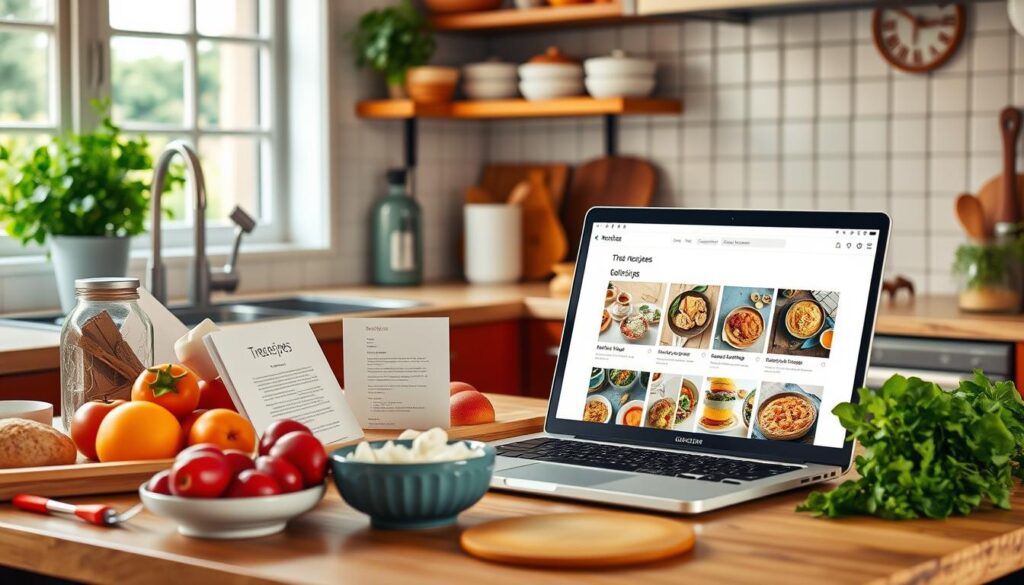
Organizing your recipes digitally is super important. Many people find their recipes are all over the place, like in random drawers. By creating a DIY Recipe Binder, you can make your recipes 50% easier to find. This is a big step in selling your recipes.
This selling recipes resource guide talks about how to keep things uniform. Use 8.5×11 inch paper for a neat look and a 3-hole punch to keep recipes together. A well-put-together binder not only keeps things tidy but also looks great, which helps in making sales.
Having the right kitchen tools, like digital scales and good mixing bowls, can really up your recipe game. These tools are must-haves for making top-notch recipes that attract buyers. Plus, things like measuring cups and parchment paper ensure your recipes turn out just right.
For those who bake, a hand mixer can save you time by quickly mixing thick cookie dough. Hand mixers and parchment paper are great for a smooth baking process. Also, knowing how to adjust recipes for high altitudes can expand your customer base.
Online platforms and software make managing your recipes and digital catalogs a breeze. They keep your recipes organized and easy to share, which helps build a community of followers. By offering free printables through email, you can get more people involved and interested.
With these tools and resources, culinary pros can not only perfect their craft but also see a big jump in recipe sales. Whether you want to get your recipes in order or boost your sales tactics, these tips will set you on the right path.
Online Marketplace Platforms
Jumping into online culinary markets opens up new chances for food entrepreneurs. You can find many platforms for selling recipes that suit different needs. They help you start digital stores and use analytics and engagement tools.

- Sellfy: You can build a digital store quickly with Sellfy. Prices begin at $19/month for Starter, go to $39/month for Business, and reach $89/month for Premium. Each option includes a 30-day money-back promise.
- Payhip: Payhip offers a free plan, Plus at $29/month, and Pro at $99/month. It stands out with security features like digital stamping and key codes.
- SendOwl: For those serious about internet-based food sales, SendOwl has plans. The Standard is $15/month, Premium $24/month, and Business $39/month.
- Podia: With yearly billing, Podia offers Mover at $390/year, Shaker at $790/year, and Earthquaker at $1,790/year. There’s a 30-day free trial to try their features.
- Squarespace: Squarespace has plans for those mixing culinary skills with design. They offer Personal at $12/month, Business at $18/month, Commerce at $26/month, and Advanced Commerce at $40/month, billed annually.
- DPD: DPD starts at $10/month for 1GB of storage. The price goes up based on how much storage you need. It includes digital stamping to protect your recipes.
- Gumroad: Gumroad caters to online creators selling different digital assets. It’s great for those looking for simplicity in internet-based food sales.
- Amazon: It’s important to note that independent sellers on Amazon’s US store sold over 4.5 billion items in 2023. That’s about 8,600 items every minute. Plus, over 10,000 sellers made more than $1 million in sales.
Many of these platforms for selling recipes let you sell without transaction fees, though Stripe and PayPal might charge processing fees. They also have analytics to watch sales and engagement. This gives you insights to help your culinary business grow. Choosing the right platform depends on what you need, like fast store setup, detailed analytics, or strong product security. Each one offers unique advantages to help you succeed in the online culinary world.
Monetizing Your Culinary Skills
Turning your love for cooking into cash is thrilling. You can sell recipes, partner with brands, or start subscriptions to monetize recipes online. These tactics not only help you earn money from cooking but also open doors to selling recipes successfully. Let’s dive into these ideas and hear some success stories from the food world.
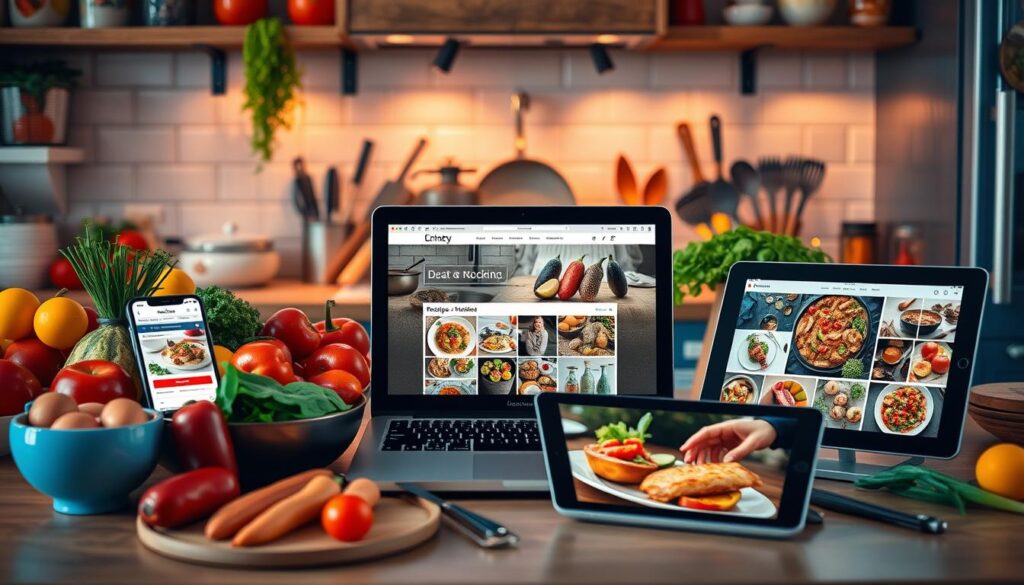
Strategies to Monetize Recipes
You can monetize recipes online by selling them directly. Etsy and Shopify let chefs sell their recipes either one at a time or in groups. Also, by using Patreon for subscriptions, you can provide special content to your biggest fans and make regular income.
Affiliate marketing is a strong strategy, too. By suggesting kitchen tools or ingredients on your blog, you can earn money from purchases made through your links. Plus, working with brands on deals and sponsorships can be very rewarding, giving you a steady flow of money.
If you’re good with a camera, making eBooks like the Tasty Food Photography by Pinch of Yum, which helped over 13,000 bloggers, is a great idea. Don’t forget the power of email newsletters, either. They bring people to your blog, increase your ad earnings, and help sell your digital products or services.
Success Stories
Rosie Alyea turned her baking blog into a success by selling sprinkles and baking goods. Her story shows that with hard work and smart money moves, you can make a career out of baking.
Tessa Arias of Handle the Heat began her baking blog right after her 18th birthday. She now makes money by selling digital and physical items, partnering with brands, and using her large email list. Her success highlights the value of having different sources of income to reduce risks and increase profits.
The chance to make money from successful recipe sales and other food-related strategies is huge. With the right tools and advice from those who’ve done it, aspiring food entrepreneurs can make their financial dreams come true.
Building a Food Blog to Promote Your Recipes
Starting a food blog requires good content, SEO, and attractive visuals. When done correctly, you can make money, gain followers, and get noticed by food lovers. It’s an exciting journey with lots of benefits.
Creating Engaging Content
To capture your audience, mix personal stories with your recipes. This blend increases reader interaction by 33%. Posts with high-quality pictures get 94% more views. So, having awesome photos is a must.
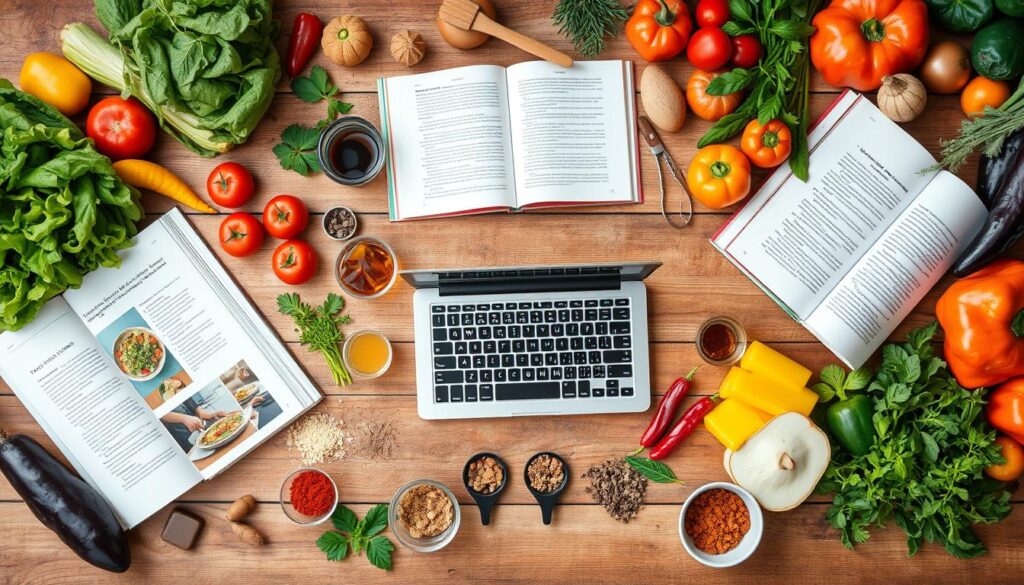
Update your blog weekly to keep readers coming back. Using tools like WP Recipe Maker can boost views by 25%. Make sure your posts are fun and simple to keep readers staying longer.
Choosing a specific food niche is smart. Specialized blogs get 26% more visits. You could focus on healthy eating or international dishes. Targeting a niche like vegan food or ethnic recipes is a strategic move, especially with their growing popularity.
SEO Tips for Food Blogs
SEO helps your blog get seen and visited more. Longer posts, over 1500 words, attract 68% more traffic. Use keyword tools to find terms that fit your content. Adding keywords like SEO for food blogs helps boost your SEO ranking.
Recipe plugins make your blog easier to find, raising your search rankings by 30%. Having a secured website with SSL certification is vital, as it builds trust with 85% of web users.
Use social media and email to spread the word about your blog. Instagram and Pinterest are perfect for food bloggers. Email marketing keeps your audience interested and brings more visitors to your site.
A good blog design and reliable hosting matter. A nice theme can keep people on your site. Hostinger’s 99.9% uptime means your blog is always available for readers. A catchy domain name also helps with clicks.
It takes time to see traffic and make money. But with patience and following these tips, your food blog can shine. You’ll create lovely posts and rank better on search engines.
Using Social Media to Sell Recipes
Social media can make your recipes famous. It lets you reach many people and connect with diverse groups. Creating good content, engaging with your audience, and using each platform’s special features can make your food stand out. One big plus is showing off recipes that look so good, people want to share them.
Instagram, Pinterest, and Facebook are great for sharing recipes. Instagram is perfect for beautiful photos and stories. Pinterest can help grow your followers, like Catch My Party did, reaching 1.7 million fans. Using special features on these platforms can bring lots more visitors to food blogs.
Talking to your followers through polls, Q&As, and live cooking shows builds a strong community. On TikTok and YouTube, your cooking videos could go viral. Adding deals, like Clariti’s 50% off for new members, can also draw people in.
Marketing recipes on social media doesn’t just get you noticed. It can also lead to deals with brands and make money. Successful food bloggers make a good income from partnerships, ads, and sponsored content. A smart plan for using social media will help turn followers into loyal fans.

